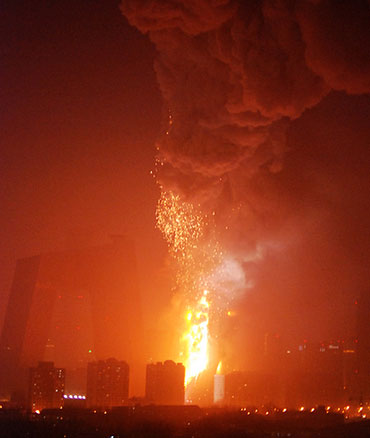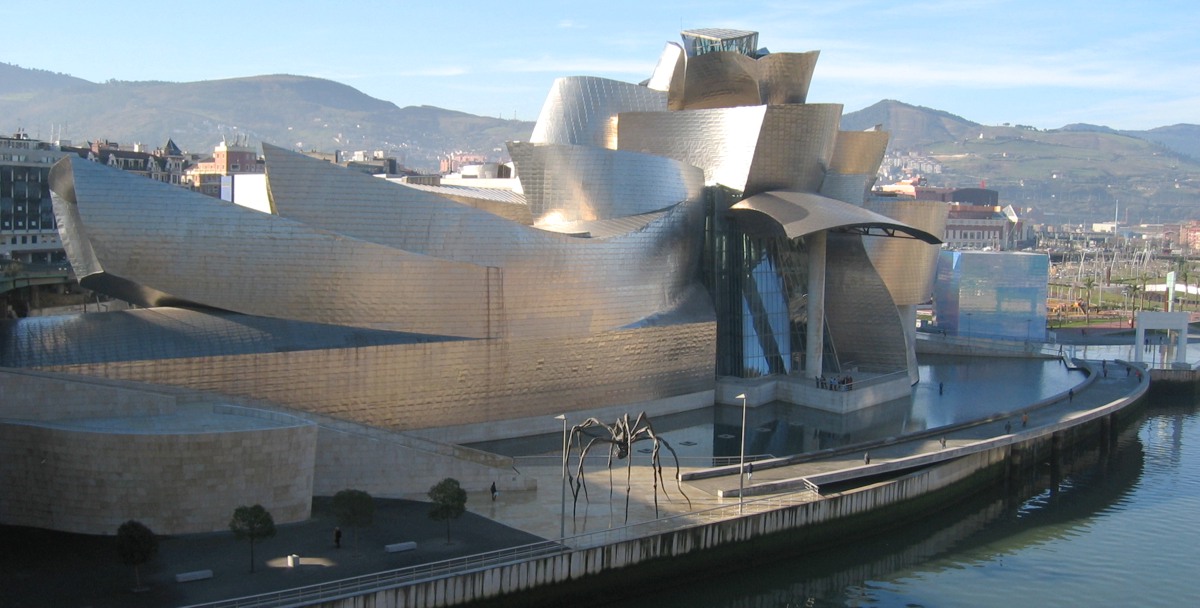I hope this bodes well for prompt scoring on my last two tests, one of which is scheduled two weeks from yesterday. My mantra these days is "just get 'em done!" I want my license by summer.
Thursday, February 19, 2009
Another One Down
Today I received another ARE score in the mail: I passed "Building Design & Construction Systems." This was the quickest turn-around I have experienced so far with the scoring report (about five weeks).
Friday, February 13, 2009
Beijing Burning: Questioning the Starchitect
 Today is Friday the 13th and architecture has been a bit unlucky this past week. On Monday, the 50-story Mandarin Oriental Hotel in Beijing, still under construction and due to open in May, burned to a crisp when an unauthorized fireworks display celebrating the Lunar New Year went horribly wrong. One firefighter died in the blaze and six people were injured. The hotel, designed by Dutch architect Rem Koolhaas and his firm OMA, was part of Central China Television's (CCTV) new headquarters complex. Unsurprisingly, CCTV has been careful to release only minimal information about the disaster through their own agency, reportedly covering the Australian wildfires much more than the fire in their own back yard.
Today is Friday the 13th and architecture has been a bit unlucky this past week. On Monday, the 50-story Mandarin Oriental Hotel in Beijing, still under construction and due to open in May, burned to a crisp when an unauthorized fireworks display celebrating the Lunar New Year went horribly wrong. One firefighter died in the blaze and six people were injured. The hotel, designed by Dutch architect Rem Koolhaas and his firm OMA, was part of Central China Television's (CCTV) new headquarters complex. Unsurprisingly, CCTV has been careful to release only minimal information about the disaster through their own agency, reportedly covering the Australian wildfires much more than the fire in their own back yard.When I first heard about the fire, I thought, "Wow, even Koolhaas' buildings can burn!" The event felt like a bit of an equalizing moment and I had a very distinct "we all have to sit down to you know what, don't we" reaction. I asked myself, "is this the end of the Starchitect?"
 Thought I do not know when the terms "Starchitect" and "Starchitecture" were first used, I seem to recall them coming into frequent use more than a decade ago when Frank Gehry's Guggenheim Museum opened in Bilbao, Spain. Back in 1997, completion of the new building literally put an unheard-of town in northern Spain on the map for tourists and art aficionados around the world. In 1998 when I entered Georgia Tech to study architecture, Bilbao was still fresh on everyone's mind, and the concept of the "Starchitect" was ingrained in us young, idealistic, star-crossed young designers.
Thought I do not know when the terms "Starchitect" and "Starchitecture" were first used, I seem to recall them coming into frequent use more than a decade ago when Frank Gehry's Guggenheim Museum opened in Bilbao, Spain. Back in 1997, completion of the new building literally put an unheard-of town in northern Spain on the map for tourists and art aficionados around the world. In 1998 when I entered Georgia Tech to study architecture, Bilbao was still fresh on everyone's mind, and the concept of the "Starchitect" was ingrained in us young, idealistic, star-crossed young designers.For more than a decade now, architects like Frank Gehry, Zaha Hadid, Norman Foster, Santiago Calatrava, Renzo Piano, and Rem Koolhaas (to name a few) have been riding a wave of landmark, high-profile projects destined to transform cities in the way Bilbao was transformed by the Guggenheim. In Beijing, the new CCTV complex, for example, along with the trendy Olympic architecture we all ogled over last summer, was intended to usher China into the new millennium in the eyes of the world. Now with the burning of a landmark work of architecture by one of the world's most prestigious architects, are we supposed to think now that China is all talk? After all, we know from the opening and closing ceremonies of the Olympics that China can put on quite a show when they want to, all the while controlling their very carefully-crafted "official" image. What is the official story on this one? This is a difficult event to sweep under the rug unnoticed.
 I suppose it is a bit of an inauspicious moment for architecture, which is already starting to feel the pains of the global economic slowdown we can not seem to hear enough about in the media. Just a few weeks ago, in fact, at a gathering with a few of my Yale classmates, I was saddened to learn that several of them had recently lost their jobs, even at prestigious, well-established architecture firms. True, even I tend to get a little giddy when I see the next "new" thing from the big-name architects, but I also continue to struggle with the ego of it all, while all the while Beijing was burning. What is it all for? Is this the end of the era of the Starchitect and the Bilbao effect? Has the playing field been leveled? (Alas, can I hope?)
I suppose it is a bit of an inauspicious moment for architecture, which is already starting to feel the pains of the global economic slowdown we can not seem to hear enough about in the media. Just a few weeks ago, in fact, at a gathering with a few of my Yale classmates, I was saddened to learn that several of them had recently lost their jobs, even at prestigious, well-established architecture firms. True, even I tend to get a little giddy when I see the next "new" thing from the big-name architects, but I also continue to struggle with the ego of it all, while all the while Beijing was burning. What is it all for? Is this the end of the era of the Starchitect and the Bilbao effect? Has the playing field been leveled? (Alas, can I hope?) And to further prove that even well-entrenched, 101 year old Modernist Starchitects must take a blow to their own ego from time-to-time, it was recently reported that Oscar Niemeyer's project for the "Plaza of Sovereignty" to commemorate the 50th anniversary of the founding of Brasilia was halted before it ever started over what seem to be concerns about budget as well as preservation of the urban fabric of central Brasilia's Monumental Axis. Oh well. At least even Modernism is up for preservation these days!
And to further prove that even well-entrenched, 101 year old Modernist Starchitects must take a blow to their own ego from time-to-time, it was recently reported that Oscar Niemeyer's project for the "Plaza of Sovereignty" to commemorate the 50th anniversary of the founding of Brasilia was halted before it ever started over what seem to be concerns about budget as well as preservation of the urban fabric of central Brasilia's Monumental Axis. Oh well. At least even Modernism is up for preservation these days!It's okay, Oscar, don't be discouraged. Rem's got nothing on you! You were designing icons while he was still in diapers!
[In an curious side note to the this story, I found it interesting to find online that conspiracy theorists have been quick to point out how the fact that the structure of the Mandarin Hotel is still standing after its vigorous fire has proven that 7 World Trade Center, which collapsed during a fire hours after the Twin Towers on September 11, 2001, was "imploded." Some people just have to make trouble don't they!]
Thursday, February 12, 2009
Five Down, Two to Go
 Today I took my "Building Systems" exam. This particular test covers mechanical, electrical, and plumbing systems with a couple of calculations and code requirements thrown in for good measure. I left the testing center feeling relatively comfortable with my performance, although there were a few calculations I did not have time to complete in time and so my answers were basically my first guess.
Today I took my "Building Systems" exam. This particular test covers mechanical, electrical, and plumbing systems with a couple of calculations and code requirements thrown in for good measure. I left the testing center feeling relatively comfortable with my performance, although there were a few calculations I did not have time to complete in time and so my answers were basically my first guess.As with my other exams, I expect it will be about two months or so before I hear whether I passed or not, at which point I hope I will have completed my last two exams remaining!
Wednesday, February 4, 2009
Pass, Pass
This past weekend I got some very good news in the mail: I passed two more AREs! This means that, as of today, I have passed 3 of my exams (Site Planning & Design, Structural Systems, and Schematic Design), I am awaiting one score for a test I took in January, and I have 3 more tests to go. I have been diligent about following my "one test every 4 weeks" schedule and so I will be taking Building Systems next week. This keeps me on track to finish testing in April, which was my goal when I started taking the AREs in October.
Subscribe to:
Posts (Atom)